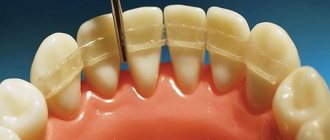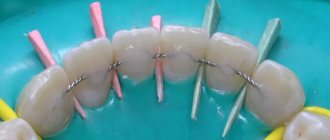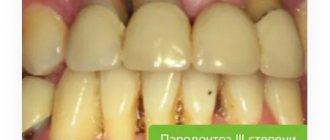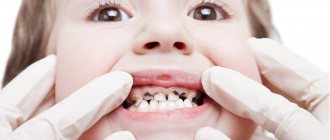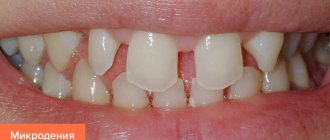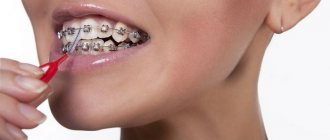The essence of splinting
To strengthen teeth using splinting, teeth are combined into one block structure. The connection is made using a bus. This is where the name “splinting” comes from.
Splinting is mainly used for the anterior dentition. This method not only preserves the chewing function, but is also quite aesthetic.
Typically, dental mobility occurs due to bone tissue atrophy. After mobility appears, the process of tooth decay begins to proceed several times faster. If splinting is not performed, teeth will be lost.
Under the influence of the “force of chewing”, the already mobile teeth begin to strongly tilt and change their original position. As a result, a kind of fan of teeth appears in the oral cavity. To stop this process, splinting is used.
Disadvantages of the method
The main disadvantage is that when installing the tire, you will need to carry out special mechanical processing of the enamel.
It is also worth considering that the product cannot be used by all patients. Much depends on the patient himself. He needs to be attentive to oral hygiene and brush his teeth on time. Otherwise, the risk of caries occurring and developing is very high. Hygiene itself will also become more difficult.
When installing a tire, you need to remember the adaptation process. During the first few days, there may be severe tooth sensitivity to sour, hot and cold foods.
Indications and contraindications for splinting
This procedure is used in the following cases:
- Dental defects, tooth shifts.
- Incorrect position of teeth.
- Restoration of teeth after braces.
- Damage to soft tissues and bleeding gums.
- Exposed roots and pronounced gum pockets.
- The presence of dental plaque, which very quickly accumulates near the root of the tooth.
A dentist can prescribe a splinting procedure after an examination and x-ray of the oral cavity.
Splinting is contraindicated in the following cases:
- Periodontal inflammation.
- With primary periodontal trauma.
- The chewing surface of the teeth has not yet been corrected by partial grinding.
- Lack of quality oral hygiene.
What is the procedure
Splinting is the fixation of mobile teeth in order to stop their further loosening and, as a result, loss. This situation is not uncommon, for example, in advanced stages of periodontitis and periodontal disease. To strengthen a row or a separate part of it, fiberglass tape, an aramid splint or a special clasp prosthesis can be used. The elements that are attached to the crowns to group them and fix them in one position remain invisible to others. You can see how the result actually looks in the photo before and after splinting.
The photo shows teeth before and after the splinting procedure
You can also achieve reliable fixation of loose teeth by installing crowns instead of missing elements nearby. These are different methods, but the essence is the same - to achieve a stable position of the movable units, correctly redistribute the chewing load in order to remove excess pressure from healthy areas, and also to provide favorable conditions for the speedy restoration of tissues and normalization of the patient’s condition.
Removable tires
When splinting, removable and non-removable splints are used. Each type has individual indications for installation and its own advantages.
Removable splints are special plates and mouth guards. With their help, it is possible to connect a certain number of teeth even if some teeth are missing. The result is a restored dentition.
The removable method is always used after mechanical damage, such as severe bruise and fracture. In this case, the treatment will fix the dentition in the correct position and prevent any change in this position.
Metal or plastic is always used to make removable tires.
Advantages of removable splinting:
- No pulp removal is required.
- There is no need to grind the surface of the teeth.
Splinting systems
- Elbrecht system. It contains clasps that are installed on the front teeth. Fixes the entire dentition very well. Typically used for first degree mobility and absence of periodontal and periodontal disease.
- One-piece mouth guard system. This is the Elbrecht system with some modification. With its help it is possible to fix the front teeth (canines, incisors). The attachment is based on protective caps that effectively protect the dental arch from uneven, increased chewing load.
- Circular tire. It has two varieties: the first is regular, the second is with claw processes. This system is very effective for severe mobility. A circular splint should not be used when teeth deviate from their axis.
How long does the result last?
A fiberglass tire can last a long time, but it has its own service life - usually about 3 years. Correction is required on average once a year to check its integrity, polish and adjust. However, in the absence of other teeth, the remaining ones will have to take on the entire chewing load, which is why the splint may soon be damaged. Thus, before the procedure, it is important to undergo treatment and prosthetics to restore the bite.
Clasp prosthetic devices are an excellent option for splinting mobile units when additional gaps in the row need to be filled. This is one of the most convenient methods of removable prosthetics, which allows you to almost completely restore the functionality of the jaw and at the same time provide the proper level of comfort. The service life of such an orthopedic device is 10-12 years or more.
Fixed tires
This splinting is used for damaged gums, as well as for very high tooth mobility. Fixed splinting of teeth is indicated for prophylactic purposes to prevent periodontal disease.
To carry out non-removable splinting, special non-removable materials are used, which provide very reliable traction, unlike the previously described tires. Typically these are crowns, clasps, threads, fiberglass and dentures.
Dentures are quite strong and durable. They are often used if one or more elements are missing in one row.
Crowns are also reliable elements. In order to place this structure in the oral cavity, it is first necessary to attach healthy teeth, depulpate them and grind them to the given required shape.
Clasp prosthetics are used when it is necessary to isolate and secure the existing dentition. The procedure with the named material is also used in cases where missing natural teeth need to be replaced with artificial ones.
Splinting with thread
Splinting with thread is prescribed to patients if all elements of the dentition are preserved. This is the most gentle method. It does not require turning or depulping, soft tissues are not injured.
Fixed splinting with thread consists of the following steps:
- Anesthesia.
- Making a smooth groove on the back surface of the dentition (depth 0.5 mm).
- A special thread is inserted into the depression made.
- The thread is secured using heliocomposite.
When performing splinting of the lower row, molars are additionally secured. For this purpose, a groove is drilled on the chewing surface, and the said thread is threaded from the upper side.
Splinting teeth with fiberglass
Fiberglass teeth splinting is one of the most aesthetic and reliable methods.
Fiberglass preserves even very loose teeth. It can be used to easily remove dental gaps.
To carry out splinting with fiberglass, it is not necessary to grind the teeth and also remove the nerve from them. All this results in minimal trauma to the oral cavity.
Materials used
Until recently, the vast majority of clinics used silk and polyethylene to solve the problem. Nowadays, higher quality materials are popular - fiberglass (aesthetics and reliability) and aramid thread (strength exceeds similar indicators of other materials by 8 times).
All materials used must meet certain requirements:
- have the ability to firmly hold loose teeth and securely attach to them,
- do not cause traumatic effects on enamel and gums,
- do not cause the patient discomfort when chewing,
- do not break diction,
- have an aesthetically attractive appearance,
- do not complicate oral care.
Pros of splinting
The positive aspects of the procedure include the following:
- The entire dentition is restored.
- Existing tooth mobility is completely eliminated.
- Effective even for age-related pathologies.
- Corrects mechanical damage.
- In case of periodontal disease, splinting helps to fully preserve the functional ability of the teeth.
- The procedure does not cause atrophy of the jaw bone.
- After installing the splints, the chewing load in the oral cavity is distributed evenly.
- With the help of splints it is possible to reduce large gaps between teeth.
- The procedure allows you to restore lost crowns after prosthetics.
- Healthy teeth are preserved during splinting, since the procedure does not require grinding or depulpation.
- Splinting structures are durable, reliable and durable.
What are the advantages of technology?
Splinting as a technique has its pros and cons. The obvious advantages of this solution include a noticeable decrease in mobility, restoration of chewing function, without pain and discomfort. Grouping loose elements into single blocks allows for a more correct and even distribution of the chewing load, which to a certain extent prevents further rapid destruction of the periodontal ligaments and resorption of the alveolar ridge.
Teeth that are united and fixed are less susceptible to deformation and change in position. It also helps to avoid reducing the height of the lower part of the face, which in turn prevents the appearance of deep wrinkles.
Disadvantages of splinting
Disadvantages of this technique:
- Oral hygiene is a little more complicated (this is due to periodontal pockets).
- Unskilled work by a dentist often causes an outbreak of dental diseases.
- The deep furrow made can reach the pulp chamber, thereby spontaneously triggering the occurrence of pulpitis.
- Sensitivity of tooth enamel may occur.
- If you do not polish your teeth enough, dental diseases may develop under the splint.
- In case of overheating or incorrect manufacturing technology, the splint may break under the chewing load.
Tags
Dental hygiene Cleaning teeth grinding teeth enamel Fluoridation of teeth Dental treatment Dental filling Removal of the dental nerve Dental implantation Dental prosthetics Dental prostheticsTelescopic prosthetics Clasp prosthetics prosthetics scheme. Periodontitis treatment Dental treatment Treatment of caries Treatment of pulpitis Treatment of gums Periodontal disease treatment Periodontitis treatment Treatment of gingivitis drug treatment. treatment methods. treatment plan with
removalreviewsbracesappointmentarticlescontactssurgeonsign upimplantwhiteningchildrenorthopedicveneerchildrenorthodontics
Special cases of splinting
Splinting for a fracture
Very often, dental patients are people with jaw fractures. In addition to the fracture itself, such patients have mobility of teeth. Then the doctor is faced with the task of fixing the bones of the entire jaw.
In such cases, only removable splinting is usually used. The splints are installed here until the jaw has completely fused.
For fractures, splints are used either from metal or plastic, which hardens very quickly. Such structures usually come in the following types:
- Double jawed. It is installed for double fractures and in difficult cases.
- Single-jawed. Used if the patient has a linear fracture of the lower jaw.
- Splinting of teeth with a spacer bend. This type of splinting is used if it is necessary to fix the bone at the fracture site and when several teeth are missing.
- Splinting with hooks. It is used if the patient has a displaced fracture. In this case, it is not possible to return the displacement to its original position.
- Smooth system. Used in cases of simple bone fractures.
Splinting of anterior teeth
The upper teeth are splinted if they are mobile and there is a risk of their fan-shaped position.
To eliminate such a defect, the dentist drills a groove 1.5-2 mm high and about 2 mm deep. Usually the groove is made on the front surface of the teeth from above. Fiberglass tape is then placed in this groove, which is then covered with a filling material (light filling). Filling material closes tooth gaps. The number of upper teeth that will be taken into the splint depends on the clinical picture of the oral cavity.
Splinting of lower teeth
Here we will talk about splinting the anterior teeth. First, a horizontal furrow is made 2 mm deep and 1.5-2 mm high. A solid fiberglass tape is placed in this groove. Then the groove with the tape is filled with a special light composite. Here, in addition to the moving teeth themselves, fixed teeth are taken into the splint. Most often it is the fangs that take on some of the brunt of the pressure.
For what reasons does the dentition become mobile?
Doctors identify many reasons why patients need to be splinted. And these include such types of diseases as:
Periodontitis. The main reason for its appearance is poor oral hygiene, as well as the characteristics of the microflora. A strong build-up of tartar can often stimulate the inflammatory process and loosen teeth. In this case, there is a gradual destruction of the fixing ligament, which connects the tooth to other tissues.
- Periodontal disease. It can be quite easily determined by external examination. The gums become whitish, although any negative sensations and pain are practically not observed. Gradually, the volume of the gums decreases, and bare roots become very noticeable. Due to insufficient supporting tissues, the tooth begins to loosen over time. Periodontal disease is often observed in patients with a weakened body due to systemic diseases or long-term treatment.
- Injury. Problems can begin if a jaw fracture has been recorded.
Other categories of patients are also at risk. If you smoke a lot, neglect advice on regular oral hygiene, or suffer from metabolic disorders, you can develop severe tooth mobility. It also manifests itself due to age or poor nutrition.
Cost of splinting
Prices for splinting vary. The amount depends on the material, the method of treatment, the complexity and characteristics of the disease.
The cost of splinting includes the price of an x-ray, since without it it is impossible to correctly diagnose and further treat. Approximately the prices for splinting are equal to the following numbers:
- Splinting with crowns – 4,000 rubles.
- Clasp prosthetics – 24,000 rubles.
- Splinting three teeth on the lateral side – 5,000 rubles.
- Fiberglass splinting of teeth – 7,000 rubles.
Orthopedic dentistry
- Orthopedic dentistry Historical sketch
- Chewing system
- Research and diagnostics in orthopedic dentistry
- Preparing the oral cavity for prosthetics
- Impression materials
- Impressions
- Clinic and prosthetics of the crown part of the tooth
- Prosthetics for dental defects
- Metal alloys used in orthopedic dentistry
- Compensation of dental defects with removable partial dentures
- Basic principles of complex treatment of periodontal disease
- Splinting
Time to splint teeth - Prosthetics of dentition defects with fixed, plate and clasp dentures for periodontal disease
- Orthodontic interventions
- Complications and mistakes when splinting teeth
- Immediate and early prosthetics
Splinting of chewing teeth
Reviews
Elena, Kyiv
Teeth became loose after periodontal disease. I thought that I would soon turn into a toothless grandmother. I cried at night. But the dentist gave me hope and said that they would do splinting. Thanks to modern materials (I was made with fiberglass), everything turned out completely different. I don’t feel any discomfort, my teeth don’t loosen, in the mirror I only see a beautiful smile.
Kirill, Orenburg
Since childhood, I had uneven teeth, which simply disfigured my face. I wore braces for many years. Gradually the teeth took on a more or less divine appearance. Not long ago, a dentist told me that for greater effect it is necessary to splint the teeth. Of course I gave my consent. You know, for the first time I'm happy with my mouth.
Olga, Perm
Several of my front teeth were loose and for some reason one quickly fell out. I went to the doctor, he splinted me. An artificial one was installed in place of the lost tooth. In appearance it cannot be distinguished from the natural one. Several years have passed, but I no longer remember which artificial tooth I have. Great!
Sergey, Orel
My sister had her teeth splinted. I went to the doctor several times. She had some special occasion. She suffered. But now everything is fine. I remember that my parents and I paid dearly for this treatment: more than twenty thousand rubles. It was a long time ago, my sister no longer remembers it. But for some reason I remember. The treatment was simply expensive!
Sources used:
- Complications during dental prosthetics and their prevention / M.G. Bhushan, H.A. Kalamkarov. — M.: Shtintsa
- I. Yu. Lebedenko, Orthopedic dentistry, 2012
- American Dental Association. "Specialty Definitions: Definitions of Recognized Dental Specialties"
Classification
Based on the duration of use, splinting systems are divided into:
- temporary;
- long-term;
- permanent.
The first ones can last up to three months. They are distinguished by their low price. If necessary, the doctor can easily modify them. These devices are designed in such a way that they do not interfere with additional therapeutic procedures.
Durable products should be worn for three months to a year. They are used if remission is achieved, but there are fears that the crown will become loose again.
Temporary and long-term splints are always a rigid thread that runs along the surface of the crowns. It is glued to the back of the teeth, so it does not affect the appearance of the smile in any way.
Permanent systems are needed if the patient is indicated for maintenance therapy. They last longer than a year. Always aesthetic, reliable and wear-resistant. Threads, removable dentures, and dental bridges act as permanent splints.


